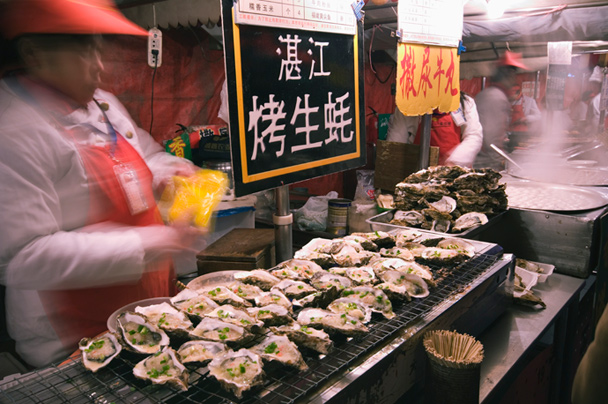It was with some trepidation that I approached this assignment. Don't get me wrong—what writer doesn't love to get paid to go on an eating spree in one of her favorite cities? Beijing now offers an eclectic embarrassment of riches as far as great restaurants go, yet navigating around this massive metropolis, especially with its unbelievable traffic delays, presents a huge challenge. The extensive subway system, completed over the last decade, is a lifesaver, and thanks to a miracle during my recent stay—a respite from the dense pollution that normally cloaks the city—I could walk off my meals and try as many places as humanly possible.
To say that the restaurant scene has blossomed—especially since my first visit in 1979, early in the post-Mao era—is an understatement. Beijing is having a big-money moment, as exemplified by the latest culinary trend: High-end restaurants that specialize in regional cuisine are sparing no expense to fly in freshly picked fruit and vegetables, fish, meats, and other specialty foods daily from their particular province of origin.
With each trip I make (the count now hovers between 30 and 40), I never cease to marvel at the extraordinary selection of eateries in the capital. For any journalist on this type of assignment, the joy is to discover the insider, not-yet-on-the radar establishments. And this last visit yielded some very exciting new finds along with some great meals at a few spots you may already have your eye on.
Jet-lagged or not, I made sure to rise early to sample the Chinese breakfast at Made in China, the renowned restaurant at the centrally located Grand Hyatt Hotel. I am a huge fan of northern-style Chinese breakfasts, which often consist of dou jiang (soybean milk seasoned with sugar or savory flavorings such as minced scallions, ginger, and hot chile paste) and yu tiao (fried Chinese crullers) stuffed into shao bing (flaky sesame seed flatbreads), as well as various dumplings, so I was thrilled that the Hyatt had begun offering a fixed-price buffet. At about $30, the tab is well worth it for an endless array of traditional Beijing treats, among them sweet and savory steamed, pan-fried, and deep-fried dumplings; six different types of congee, including sweet potato and assorted grains such as black rice, corn flour, and sorghum; multiple soups; spring rolls; thin pancakes stuffed with crisp Peking duck skin and tender meat; and a number of other hard-to-find classics.
Many argue—and I agree—that if you are traveling to Beijing, there are certain local specialties that are a must to try, especially dumplings and noodles. So if you haven't gotten your fill of dumplings at the Hyatt for breakfast, don't miss lunching at Xian Lao Man, which, again, specializes in northern-style food. A favorite of Chinese art curator Nancy Berliner of Massachusetts' Peabody Essex Museum, it is a no-frills local hangout, and though we didn't encounter any English speakers on staff, there's a Chinglish menu and the service was very friendly. The pan-fried dumplings, or guo tieh, were delicious and simply but elegantly presented; of the many selections, we opted for a filling of fresh dill and egg. Other not-to-be missed dishes include braised bamboo shoots and crisp, deep-fried mildly hot green chile peppers.



 Pinterest
Pinterest


